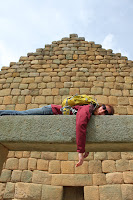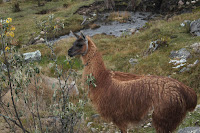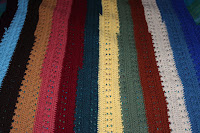


Late in the day last Thursday, after our weekend plans changed from fieldwork to free, we decided it was time to take our wheels for a spin out of town. We made reservations at the Cabanas del Rio Yambala in Vilcabamba and decided that however things worked out we would be happy to be in a place much warmer than where we live.
Friday afternoon it was raining, Brad’s surgery ran late, and our friend Jose locked himself out of his house and needed us to come with our copies of the keys. We were not to be discouraged. We FINALLY got out of town and after driving awhile witnessed the most beautiful sunset either one of us had ever enjoyed. The sky was filled with layers of clouds, each reflecting the sun in different shades of pink and orange. The mountains were glowing. And traffic wasn’t too awful.
When we arrived in Loja, we were ready for a meal. Jose had given us directions as far as Loja, then he suggested that we ask someone there how to get to the road to Vilcabamba. So we stopped at an upscale restaurant that specializes in serving large quantities of meat and ordered the junior portion and a pitcher of lemonade—we figured we could ask the waiter for directions. After about 30 minutes, our meat arrived and was accompanied by a salad, fried yucca, choclo (large kernels of bland tasting corn) and two different sauces (one red and one green). The meat itself included beef, pork, and chicken served on a special platter with hot coals underneath the food. Yeah, I know, we don’t usually eat meat and have been known to go weeks without it. However, when in Rome… so we ate the meat, and we enjoyed it! Then we got directions from the cashier, the parking attendant, a police officer, and a young teenage couple. One step at a time, we made it out of town and on our way.
We got into Vilcabamba later than planned, and repeated the same course of asking for directions until a very gringo-looking teenage boy who was checking facebook on his cellphone greeted us at the entrance of our hostel. He spoke to us without an accent, then informed us that his mom is from England and his dad is from the US. He showed us the way to our own private cabana, then pointed out their house in case we needed anything. We settled in, and slept well until morning. Later we met his father, Charlie, who is a really nice guy who was particularly interested in talking to us about our Vitara—apparently he’s considering upgrading his truck to a small SUV. They own a large bioreserve, “Las Palmas,” which is adjacent to Podacarpus National park and where Charlie makes a little extra cash by harvesting and selling honey.
Sometimes these small towns shut down for the weekend at 1:00 on Saturdays, so I was anxious to have a look around while the shops were still open. We drove ourselves the 5km from our cabana into town and found that at 10:00 it was just starting to wake up. We walked into some artisan shops, one of which closely resembled a craft show in the Midwest, and quickly discovered that many of the shops and cafes are run by ex-pats. No need to speak Spanish here. We inquired at a few different places about horseback riding, and Brad chose the most expensive one. Gavin, the guy from New Zealand (although he’s been in south America for 30+ years), convinced us that although he charges more, the money goes into taking care of the horses. His horses looked great compared to some of the others we had seen, so we scheduled a 4 hour ride for Sunday morning.
After a delicious but over-priced meal of Mexican food at “El Jardin Escondido” (the hidden garden), and stopping to purchase chocolate covered guava nibs, we headed back to our hostel. We tried to hike to the waterfall, but never made it because the directions (provided by the hostel) were a bit confusing. We tried to hike to the swimming hole, but it was much farther away than we anticipated and we had to make it back for 6:00 dinner (the hostel is obviously run by foreigners. People here don’t even begin to think about dinner until 7:00, and they really call it a “snack” and the portions are about snack size). We settled on great views of the valley and we dipped our toes in the lesser of the two swimming holes (which was okay by me because the water was COLD!) We hiked back and sat down to a delicious, uncharacteristically large dinner of mashed potatoes, salad, chicken in peanut sauce, and a piece of cake. Another young couple from England joined us and told us a bit about their 9 mo. Holiday through North and South America.
So our horseback ride. Gavin had told us that he wasn’t available to do the tour, but that his partner would take us on a great ride. We arrived at 9:10, and Gavin himself was standing there waiting for us. He apologized, and said, “My partner who was supposed to take you is still drinking, the other partner got p***** and said ‘you do it,’ and so I said ‘alright, I’ll do it,” all in a fading but still present kiwi accent. Apparently a local family had moved to Spain for 15 years and had just returned this weekend, spurring a large-scale celebration.
We decided to do a circuit in the mountains around the city hat would offer a nice view into the valley. I was not thrilled when the ride started off on paved roads, but eventually we made it to some pretty awesome trails that provided the horses with a bit of a challenge. I’ve been on horseback in the US, and typically they make you wear a helmet and the horses themselves are trained to walk as if they are half-dead. Not these horses. We walked, we trotted, and we galloped through beautiful, mountainous terrain. Along the way, Gavin pointed out gated communities and mansions owned by foreigners. He told stories about the man who had an elevator installed in his mansion after having a heart attack, the man who bought the land and put in a road but ran out of money before he started building a house, the man who heard $125,000 for a piece of land when the seller had only asked for $25,000. Apparently Gavin has published a book of stories called “Vilcabamba, valley of strange fruits” specifically about the eccentric and crazy foreigners who have changed the culture of the small town.
When we arrived back in town, Gavin showed us to a small shop where we could get a juice and the best chocolate chip cookies in town. They actually weren’t too far off from the oatmeal cookies I make at home, and after eating 5 we bought 5 more for the trip home. Then Gavin recommended a pizza shop called “Charlitos” where Brad and I shared a cheese pizza for $4.50, and it really was pretty good (or at least our idea of what is good has changed). At 3:00 we headed out of town.
I wanted to stop at a little town called Saraguro on the way back. It is known for the traditional style of dress, culture, and handicrafts. It was after 6:00 by the time we arrived, but the church was lit up and the center of town was in the process of being renovated. Mass was just starting as we walked up to the church, so we stayed awhile then got some drinks in a little café called “mama cuchara” where we were served by two girls in the traditional dark colored dress with beautiful and brightly colored beaded collars. For a natural juice of the fruit babaco and a sprite, it cost $1.05. Amazing. Unfortunately the market was closed so we’ll have to go back.
So we continued along the Panamericana, until the road won in the contest: tire vs road. It was dark, we were on a large highway at least 10 miles from the next town, and we had a choice: call the insurance company and wait for them to make the drive from Cuenca or change the tire ourselves. Brad elected to change the tire, and I was his look-out. Luckily, the government here requires you to have certain things in your car: a first aid kit, a fire extinguisher, and reflective triangles. We set up the triangles, put our headlamps on (seriously, you should ALWAYS have a headlamp with you) and got to work. The road really wasn’t too busy, and Brad had several minutes in between traffic to get the tire off, lift the car with the jack, and tighten the new tire into place. Success, after about 30 minutes we were on our way again—with plans to take the car in for the much needed, new tires on Monday morning.
All in all, it was a great weekend. We got to warm up and have some fun, and we succeeded in another adventure. This week, Brad’s back to work in the hospital and I’m back to work in the field. Yesterday (Tuesday) I began constructing a 3x3x2m house for my tadpole development project, then in the afternoon I found an Atelopus exiguus (the critically endangered, really awesome species that is the reason I’m here). Good news for the project, and a big relief for me!

































